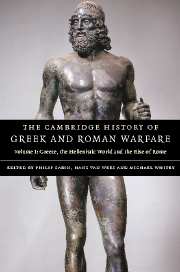Book contents
- Frontmatter
- Introduction: The Historiography of Ancient Warfare
- Part I Archaic and Classical Greece
- Part II The Hellenistic World and the Roman Republic
- 10 International relations
- 11 Military forces
- 12 War
- 13 Battle
- 14 Warfare and the state
- 15 War and society
- Chronological Table
- Glossary
- List of Ancient Authors
- Bibliography
- Index of ancient passages cited
- General index
- Map 1 The western Mediterranean
- Map 3 The Near East
- References
11 - Military forces
from Part II - The Hellenistic World and the Roman Republic
Published online by Cambridge University Press: 28 March 2008
- Frontmatter
- Introduction: The Historiography of Ancient Warfare
- Part I Archaic and Classical Greece
- Part II The Hellenistic World and the Roman Republic
- 10 International relations
- 11 Military forces
- 12 War
- 13 Battle
- 14 Warfare and the state
- 15 War and society
- Chronological Table
- Glossary
- List of Ancient Authors
- Bibliography
- Index of ancient passages cited
- General index
- Map 1 The western Mediterranean
- Map 3 The Near East
- References
Summary
the age of philip and alexander
Military demography
In the classical Greek poleis, the exclusive nature of citizenship restricted the expansion of armies, while the lack of state finances limited the development of tactical diversity. Mass emancipation into the citizenry had taken place during the archaic period, but during the classical period citizenship became increasingly exclusive. The manpower losses suffered in many states (such as Athens) during the Peloponnesian War were never replaced.
Another factor reducing the size of hoplite forces was the decline in personal wealth evident during the fourth century. Fewer Greeks were able to provide themselves with hoplite weaponry, either for the service of their own state or for mercenary service abroad. In 401 the 10,000 ‘Cyrean’ mercenaries consisted of 10,400 hoplites and only 2,500 peltasts: a proportion of four to one. By 374/3, when Iphicrates was appointed to command the Greek mercenaries assembled for the planned invasion of Egypt, it would seem that the majority of these ‘Iphicrateans’ were without hoplite equipment.
Keywords
- Type
- Chapter
- Information
- The Cambridge History of Greek and Roman Warfare , pp. 325 - 367Publisher: Cambridge University PressPrint publication year: 2007
References
- 11
- Cited by

